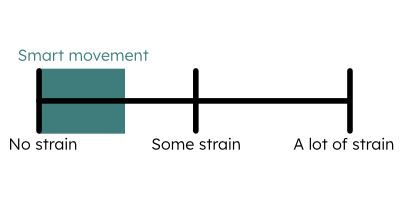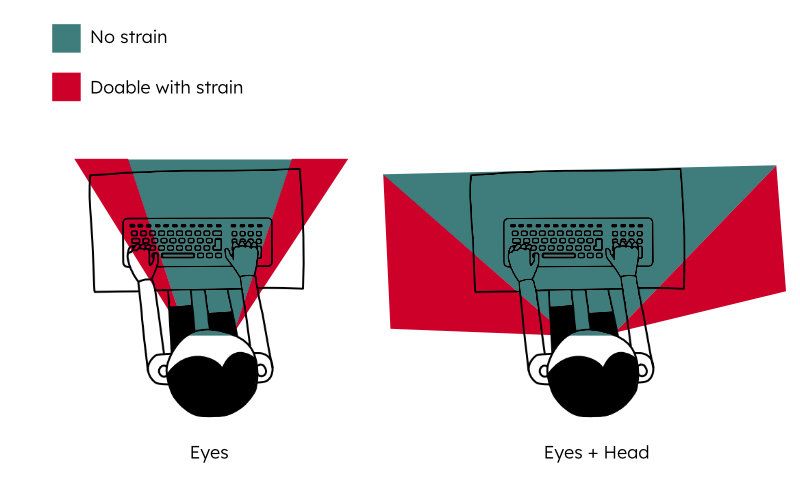Reduce neck strain by moving smart
Smart movement is a way of moving without strain. Learn how to avoid neck pain by moving within your comfort zone.
Muscle strain in non-exercise situations happens when we use our muscles for tasks they aren't meant to do. The one we tech folks are most familiar with is neck strain.
With a bit of smart movement, I believe we can avoid some of the pain that plagues most computer-laden lives.
No strain policy
Every movement we do in life can be done with no strain, some strain, or a lot of strain. Smart movement is a type of movement where there is little to no strain.

As an illustration of the concept, let's take a look at the simple movement of looking behind yourself.
Movement chain as a smart movement experiment
Please sit on the edge of your chair in a way that feels safe. If any movement during the experiment feels strenuous, please do less.
Imagine there is someone calling you from behind. How would you look towards them? Notice the way you do it, what exactly you're looking at, and how hard or easy it feels.
In the rest of the experiment you will be building a movement chain, where every new element adds a link to that chain. Every time you add a link, you will move from the newest link to the oldest one.
I'm intentionally not giving you a video for this experiment—it is important for you to discover your own body and develop your own sensations.
Link 1 - Eyes
Using only your eyes, slowly look to the right. Notice how much you can look to the right without feeling any strain.
You don't need to look all the way to the right—your comfort comes first. When you find a comfortable position for your eyes that you think you could easily sustain for the entire day, notice what you're looking at. Return to the middle.
Link 2 - Head
Slowly move your head to the right. When you start feeling strain on your neck, move back to where you don't feel it, and stop there.
Now move link 1, the eyes. Notice what you're looking at now, and then return to the middle.
Link 3 - Shoulders
Rotate your shoulders to the right, and find a comfortable position—that's a position where you feel like you could move more if you wanted to.
Move links 2 and 1. Notice what you're looking at, and return to the middle.
Link 4 - Torso
Rotate your torso to the right, never reaching the end of the movement. This will most likely be a smaller movement than with the shoulders, but try to feel it.
Stay in a position that you can easily hold. Move links 3, 2, and 1—all in a sustainable fashion like before.
Notice what your eyes see now, and then return to the middle.
Link 5 - Hips
If you're not used to moving your hips, this one might be a bit challenging. Don't worry if you don't get it at first—just imagining will also make a difference.
Try to find a way to slightly rotate your hips to the right. Remember to not go until the end of the movement.
Move links 4, 3, 2, and 1. Notice what you're looking at now, and return to the middle.
Link 6 - Legs
Plant your feet on the floor. Push with the feet so your knees both go a bit to the right. As always, don't go to the end of the movement.
Now move links 5, 4, 3, 2, and 1. In words, rotate your hips to the right. Then rotate the torso and the shoulders. Move your head, and lastly the eyes—never going to the end of the movement.
What are you looking at now? Is it different than in the beginning? Does the movement feel any easier or harder than before?
When you're ready, return to the middle.
Smart movement
You're probably not looking behind you all the time, but you're most likely looking down at your laptop screen, or to the side at multiple monitors. This is where smart movement can really make a difference.
The idea is to stay in a comfortable range of motion no matter what you do.

If a movement you want to do is small, you might only need one link in the chain. If it's slightly bigger, it's better to add another link so both links feel comfortable rather than risk straining the smallest link.
I encourage you to start noticing how you move as you do your day-to-day work. If you notice that a part of you is straining, see if you can include more of yourself in the movement.
If you're willing to share, I would love to hear how the experiment went for you—just send me an email to seb@healthyfolks.tech.
Thanks for your time,
Seb. 🙇♂️
❤️ Found this newsletter helpful?
Forward to a tech friend and let them know where they can subscribe (hint: it's here).
